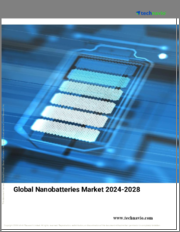
|
시장보고서
상품코드
1658025
나노 배터리 시장 규모, 점유율, 성장 분석 : 유형별, 용도별, 지역별 - 산업 예측(2025-2032년)Nano Battery Market Size, Share, and Growth Analysis, By Type (Lithium-Ion, Zinc- Manganese), By Application (Consumer Electronics, Medical Devices), By Region - Industry Forecast 2025-2032 |
||||||
나노 배터리 시장 규모는 2023년 74억 달러로 평가되며, 2024년 88억 2,000만 달러에서 2032년 359억 5,000만 달러로 예측 기간(2025-2032년) 동안 19.2%의 CAGR로 성장할 것으로 예상됩니다.
세계 나노 배터리 시장은 가전, 전기자동차, 군사용 등 다양한 분야에서 에너지 저장 솔루션에 대한 수요 증가로 인해 큰 성장세를 보이고 있습니다. 나노 입자를 통합하여 전극에서 액체를 분리하여 배터리 성능을 향상시키고, 이를 통해 저장 기간을 연장하여 2027년까지 시장 수요를 증가시킬 수 있습니다. 100 나노미터 이하의 크기를 가진 이 경량 배터리는 스마트폰, 노트북과 같은 휴대용 기기에 필수적입니다. 탄소나노튜브의 부상과 배터리 기술의 발전은 이 분야를 더욱 촉진하고 있으며, 첨단 실리콘 나노와이어 음극 배터리 개발을 목표로 하는 Amprius Technologies와 Airbus Defence and Space와의 파트너십이 주목받고 있습니다. 혁신적인 배터리 솔루션에 대한 지속적인 투자는 나노 배터리 시장의 상승세를 유지할 것으로 보입니다.
목차
소개
- 조사 목적
- 조사 범위
- 정의
조사 방법
- 정보 조달
- 2차와 1차 데이터 방법
- 시장 규모 예측
- 시장 가정과 제한
주요 요약
- 세계 시장 전망
- 공급과 수요 동향 분석
- 부문별 기회 분석
시장 역학과 전망
- 시장 개요
- 시장 규모
- 시장 역학
- 성장 촉진요인과 기회
- 성장 억제요인과 과제
- Porters 분석
주요 시장 인사이트
- 핵심성공요인
- 경쟁 정도
- 주요 투자 기회
- 시장 생태계
- 시장 매력 지수(2024년)
- PESTEL 분석
- 거시경제 지표
- 밸류체인 분석
- 가격 분석
- 사례 연구
- 기술 분석
- 규제 분석
- 특허 분석
나노 배터리 시장 규모 : 유형별 & CAGR(2025-2032년)
- 시장 개요
- 리튬이온
- 아연-망간
- 니켈 수소
- 기타
나노 배터리 시장 규모 : 용도별 & CAGR(2025-2032년)
- 시장 개요
- 가전
- 의료기기
- 웨어러블 디바이스
- 스마트 카드
- REID
- 기타
나노 배터리 시장 규모 & CAGR(2025-2032년)
- 북미
- 미국
- 캐나다
- 유럽
- 독일
- 스페인
- 프랑스
- 영국
- 이탈리아
- 기타 유럽
- 아시아태평양
- 중국
- 인도
- 일본
- 한국
- 기타 아시아태평양
- 라틴아메리카
- 브라질
- 기타 라틴아메리카
- 중동 및 아프리카
- GCC 국가
- 남아프리카공화국
- 기타 중동 및 아프리카
경쟁 정보
- 상위 5개사의 비교
- 주요 기업의 시장 포지셔닝(2024년)
- 주요 시장 기업이 채용한 전략
- 최근의 시장 동향
- 기업의 시장 점유율 분석(2024년)
- 주요 기업 개요
- 기업 상세
- 제품 포트폴리오 분석
- 기업 부문별 점유율 분석
- 매출 전년비 비교(2022-2024년)
주요 기업 개요
- LG Chem Ltd.(South Korea)
- Samsung SDI Co. Ltd.(South Korea)
- Panasonic Corporation(Japan)
- Sony Corporation(Japan)
- Amprius Technologies Inc.(US)
- Targray Technology International Inc.(Canada)
- Enevate Corporation(US)
- QuantumScape Corporation(US)
- Altairnano(US)
- Pellion Technologies(US)
- Aleees(Taiwan)
- Ambri(US)
- Amprius(US)
- Angstron Materials(US)
- Applied Materials(US)
- Blue Solutions(France)
- Cnano Technology(China)
- EnZinc(US)
- Hitachi Maxell(Japan)
- Nano One Materials Corp.(Canada)
- NEI Corporation(US)
- XG Sciences(US)
결론과 제안
ksm 25.03.26Nano Battery Market size was valued at USD 7.4 billion in 2023 and is poised to grow from USD 8.82 billion in 2024 to USD 35.95 billion by 2032, growing at a CAGR of 19.2% during the forecast period (2025-2032).
The global nano battery market is experiencing significant growth, driven by increasing demand for energy storage solutions across various sectors, such as consumer electronics, electric vehicles, and military applications. The incorporation of nanoparticles enhances the batteries' performance by separating liquids from electrodes, thereby extending shelf life and boosting market demand through 2027. With a size of less than 100 nanometers, these lightweight batteries are integral to portable devices like smartphones and laptops. The rise of carbon nanotubes and advancements in battery technology further propel this sector, highlighted by partnerships like the one between Amprius Technologies and Airbus Defence and Space, aimed at developing advanced silicon nanowire anode batteries. The continued investment in innovative battery solutions will likely sustain the upward trend in the nano battery market.
Top-down and bottom-up approaches were used to estimate and validate the size of the Nano Battery market and to estimate the size of various other dependent submarkets. The research methodology used to estimate the market size includes the following details: The key players in the market were identified through secondary research, and their market shares in the respective regions were determined through primary and secondary research. This entire procedure includes the study of the annual and financial reports of the top market players and extensive interviews for key insights from industry leaders such as CEOs, VPs, directors, and marketing executives. All percentage shares split, and breakdowns were determined using secondary sources and verified through Primary sources. All possible parameters that affect the markets covered in this research study have been accounted for, viewed in extensive detail, verified through primary research, and analyzed to get the final quantitative and qualitative data.
Nano Battery Market Segments Analysis
Global Nano Battery Market is segmented by Type, Application and region. Based on Type, the market is segmented into Lithium-Ion, Zinc- Manganese, Nickel-Metal Hydride and Others. Based on Application, the market is segmented into Consumer Electronics, Medical Devices, Wearable Devices, Smart Cards, REID and Others. Based on region, the market is segmented into North America, Europe, Asia Pacific, Latin America and Middle East & Africa.
Driver of the Nano Battery Market
The increasing demand for consumer electronics, including smartphones, tablets, and laptops, significantly propels the global nano battery market. These advanced batteries provide superior energy density and extended longevity in comparison to conventional battery technologies, making them highly suitable for energizing a variety of electronic gadgets. As manufacturers strive to meet consumer expectations for longer-lasting and more efficient devices, the appeal of nano batteries continues to rise. Their ability to deliver enhanced performance aligns perfectly with the evolving needs of the tech industry, thereby driving further innovation and adoption within the market landscape.
Restraints in the Nano Battery Market
Despite the advantages of nano batteries, such as enhanced energy density and extended lifespan relative to conventional batteries, their performance remains a significant constraint. Presently, nano batteries may struggle to deliver the necessary power for high-demand applications, including electric vehicles and large-scale energy storage solutions. This performance limitation could hinder the widespread adoption of nano batteries across diverse sectors, ultimately impacting their market growth. Consequently, until advancements are made to address these performance challenges, the potential of nano batteries may not be fully realized, thereby acting as a restraint on their broader implementation and acceptance in various applications.
Market Trends of the Nano Battery Market
As of October 2023, the global nano battery market is experiencing robust growth propelled by the surging demand for portable electronic devices, including smartphones, laptops, and wearables. The evolution of consumer preferences for smaller, lighter products has created a niche for nano batteries, which are characterized by their impressive energy density and extended lifespan, making them ideal for seamless integration. Furthermore, advancements in nanotechnology are enhancing battery performance, safety, and charge efficiency, fostering innovation and competitiveness in this sector. As manufacturers increasingly prioritize sustainability and power efficiency, the nano battery market is poised for substantial expansion in the coming years.
Table of Contents
Introduction
- Objectives of the Study
- Scope of the Report
- Definitions
Research Methodology
- Information Procurement
- Secondary & Primary Data Methods
- Market Size Estimation
- Market Assumptions & Limitations
Executive Summary
- Global Market Outlook
- Supply & Demand Trend Analysis
- Segmental Opportunity Analysis
Market Dynamics & Outlook
- Market Overview
- Market Size
- Market Dynamics
- Drivers & Opportunities
- Restraints & Challenges
- Porters Analysis
- Competitive rivalry
- Threat of substitute
- Bargaining power of buyers
- Threat of new entrants
- Bargaining power of suppliers
Key Market Insights
- Key Success Factors
- Degree of Competition
- Top Investment Pockets
- Market Ecosystem
- Market Attractiveness Index, 2024
- PESTEL Analysis
- Macro-Economic Indicators
- Value Chain Analysis
- Pricing Analysis
- Case Studies
- Technology Analysis
- Regulatory Analysis
- Patent Analysis
Global Nano Battery Market Size by Type & CAGR (2025-2032)
- Market Overview
- Lithium-Ion
- Zinc- Manganese
- Nickel-Metal Hydride
- Others
Global Nano Battery Market Size by Application & CAGR (2025-2032)
- Market Overview
- Consumer Electronics
- Medical Devices
- Wearable Devices
- Smart Cards
- REID
- Others
Global Nano Battery Market Size & CAGR (2025-2032)
- North America (Type, Application)
- US
- Canada
- Europe (Type, Application)
- Germany
- Spain
- France
- UK
- Italy
- Rest of Europe
- Asia Pacific (Type, Application)
- China
- India
- Japan
- South Korea
- Rest of Asia-Pacific
- Latin America (Type, Application)
- Brazil
- Rest of Latin America
- Middle East & Africa (Type, Application)
- GCC Countries
- South Africa
- Rest of Middle East & Africa
Competitive Intelligence
- Top 5 Player Comparison
- Market Positioning of Key Players, 2024
- Strategies Adopted by Key Market Players
- Recent Developments in the Market
- Company Market Share Analysis, 2024
- Company Profiles of All Key Players
- Company Details
- Product Portfolio Analysis
- Company's Segmental Share Analysis
- Revenue Y-O-Y Comparison (2022-2024)
Key Company Profiles
- LG Chem Ltd. (South Korea)
- Company Overview
- Business Segment Overview
- Financial Updates
- Key Developments
- Samsung SDI Co. Ltd. (South Korea)
- Company Overview
- Business Segment Overview
- Financial Updates
- Key Developments
- Panasonic Corporation (Japan)
- Company Overview
- Business Segment Overview
- Financial Updates
- Key Developments
- Sony Corporation (Japan)
- Company Overview
- Business Segment Overview
- Financial Updates
- Key Developments
- Amprius Technologies Inc. (US)
- Company Overview
- Business Segment Overview
- Financial Updates
- Key Developments
- Targray Technology International Inc. (Canada)
- Company Overview
- Business Segment Overview
- Financial Updates
- Key Developments
- Enevate Corporation (US)
- Company Overview
- Business Segment Overview
- Financial Updates
- Key Developments
- QuantumScape Corporation (US)
- Company Overview
- Business Segment Overview
- Financial Updates
- Key Developments
- Altairnano (US)
- Company Overview
- Business Segment Overview
- Financial Updates
- Key Developments
- Pellion Technologies (US)
- Company Overview
- Business Segment Overview
- Financial Updates
- Key Developments
- Aleees (Taiwan)
- Company Overview
- Business Segment Overview
- Financial Updates
- Key Developments
- Ambri (US)
- Company Overview
- Business Segment Overview
- Financial Updates
- Key Developments
- Amprius (US)
- Company Overview
- Business Segment Overview
- Financial Updates
- Key Developments
- Angstron Materials (US)
- Company Overview
- Business Segment Overview
- Financial Updates
- Key Developments
- Applied Materials (US)
- Company Overview
- Business Segment Overview
- Financial Updates
- Key Developments
- Blue Solutions (France)
- Company Overview
- Business Segment Overview
- Financial Updates
- Key Developments
- Cnano Technology (China)
- Company Overview
- Business Segment Overview
- Financial Updates
- Key Developments
- EnZinc (US)
- Company Overview
- Business Segment Overview
- Financial Updates
- Key Developments
- Hitachi Maxell (Japan)
- Company Overview
- Business Segment Overview
- Financial Updates
- Key Developments
- Nano One Materials Corp. (Canada)
- Company Overview
- Business Segment Overview
- Financial Updates
- Key Developments
- NEI Corporation (US)
- Company Overview
- Business Segment Overview
- Financial Updates
- Key Developments
- XG Sciences (US)
- Company Overview
- Business Segment Overview
- Financial Updates
- Key Developments

















